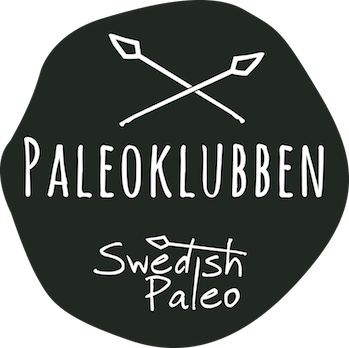
Läs The Paleo Magazine
Vi du läsa om paleo i USA så är ett tips att följa och prenumerera på http://paleomagonline.com
Detta är världens första magasin online som bara publicerar nyheter och intervjuer om paleo.
Denna tidning är riktig guldgruva!
Här är lite info från deras sida:
What is Paleo?
The notion of “Paleo” as a diet and lifestyle descriptor developed from the study of evolutionary biology, and the assimilation of ancestral foodways from around the globe. With a commitment to good science, rigorous research, epidemiological studies and plenty of anecdotal evidence to boot, “Paleo” has evolved from a little-known nickname for a prehistoric era to a diet and lifestyle template that is sweeping the nutrition scene, helping to reinvigorate the health and happiness of millions of people.
But what, many ask, is Paleo?
Photo by Hans Splinter
Quite simply, Paleo provides a model for holistically healthy living. The Paleo diet recommends whole, nutrient-dense foods, and is at its most basic an elimination diet. By removing many of the causes of allergies and autoimmune disorders, as well as the processed food-like products brought about by modern manufacturing, the human body is able to detox from foreign substances and naturally reset those basic functions that make eating, breathing and moving so effortless in a healthy system. At its simplest, Paleo is a return to the basics—it is the human diet that works with our genetics, not against it.
Photo by Klearchos Kapoutsis
Paleo looks to ancestral wisdom—whether from cave-dwelling Paleolithic ancestors or remote native populations untouched by Western disease—for guidance on what to eat and how to live. The foods that our great, great grandparents wouldn’t have recognized in our modern supermarkets shouldn’t be food for us in the first place, and Paleo offers guidance in avoiding those products that do more harm than good. As it is, the modern human body is assaulted on all sides by environmental pollutants that are toxic to our basic chemical processes; avoiding these contaminants, in addition to the many additives found in foods, assists our body to reach vibrant wellness on its own, often without the help of medicine or invasive surgery.
The Paleo diet advises the avoidance of grains, gluten, legumes, low-fat pasteurized and homogenized dairy, corn, soy and sugar. Instead, fill up on grass-fed meat from ruminants like cattle, bison, goats, lamb or wild game. Seek out pastured chicken, eggs and pork, and prioritize wild-caught fish and seafood whenever possible. Do your part to support your local economy and agricultural system by consuming local, organic fruits and vegetables whenever possible, or grow your own to be even more sustainable. Try your hardest to limit your exposure to rancid seed oils like canola, corn, soy, sunflower or safflower oils, and instead use pastured animal fats like lard, tallow or schmaltz, coconut oil, grass-fed ghee or cold-pressed olive oil for your cooking, baking and drizzling needs. Nuts and seeds are also included in a Paleo diet, and offer a healthy alternative in a diet devoid of conventional snacks.
Many people find that chocolate, some dairy, some alcohol or other such items fit nicely into their personal Paleo template—and this is fine. The Paleo diet offers an evolutionary framework for the most nutritious way of eating, but the fact remains that everybody—and every body—is different. Try the Paleo template at its most basic before adding or subtracting. You may discover food intolerances, reactions, or new favorite ingredients along the way that could shape how you eat for the rest of your life.
Along with the diet component, Paleo seeks to address serious ailments caused by modern living. With a focus on stress reduction, community engagement and support, fitness and play, exposure to nature and honoring the body’s circadian rhythms, Paleo encompasses so much more than just food.
Fitness
Photo by Zach Dischner
Smart exercise is an important component of Paleo. With a focus on weight-bearing loads, mobility and lots of slow, sustained movement, we can model the fitness patterns of our ancestors to promote both peak physical performance and longevity with minimal effort. No longer are health-conscious folk relegated to the cardio machines at the gym; rather, Paleo recommends combining pleasure with prescription, and taking exercise outdoors whenever possible. Compete in a sport or play with the kids, go for a walk downtown or a hike through the woods, kayak, sprint, deadlift or swing kettlebells. Whatever you do, do it with joy and with a focus on long-term results.
Sleep
Photo by Relaxing Music
Sleep is an integral part of fitness, as recovery makes up a significant proportion of the body’s overall performance level. To improve sleep, limit exposure to artificial light after sundown to reduce disruption of the circadian rhythm, and sleep for at least eight hours whenever possible in a dark, cool room. Whenever possible, align sleep patterns with the cycles of the sun.
Kommentarer
2 svar till “Läs The Paleo Magazine”
Lämna ett svar





 Photo by Hans Splinter
Photo by Hans Splinter Photo by Klearchos Kapoutsis
Photo by Klearchos Kapoutsis Photo by Zach Dischner
Photo by Zach Dischner Photo by Relaxing Music
Photo by Relaxing Music




THE ONLY HEALTHY COOKBOOK YOU WILL EVER NEED…
With over 470 easy-to-prepare Paleo recipes and 10 week meal plan, you can stop stressing about your food, and start enjoying the healthy energetic body, weight loss, mental sharpness, and positive attitude you gain from eating only wholesome, natural ingredients that truly nourish. Click here ->> http://fb.me/2mI6fgfIs
As a mother of 3 semi-picky little ones, I was very worried I would have a hard time living the Paleo lifestyle while still providing nutritious, tasty food for my family. I would like to say, that after using your book for 2 weeks now, there has only been 1 dish they haven’t liked (still working on getting them to like brussels sprouts as much as I do). I would recommend this to any mom or dad who wants to make a positive change for themselves and their family. Click here –> fb.me/7H7fkQGgo